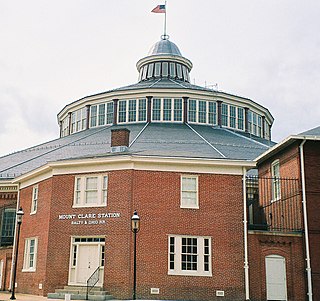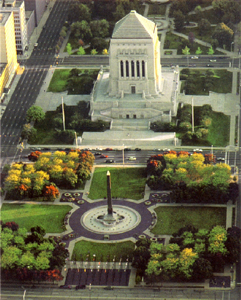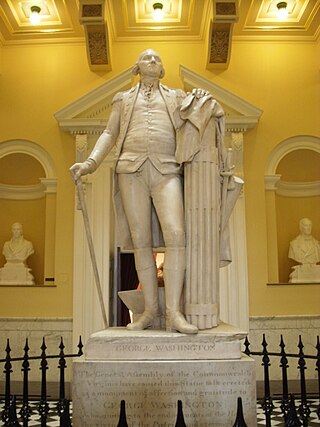
The Liberty Bell, previously called the State House Bell or Old State House Bell, is an iconic symbol of American independence located in Philadelphia. Originally placed in the steeple of Pennsylvania State House, now known as Independence Hall, the Liberty Bell today is located across the street from Independence Hall in the Liberty Bell Center in Independence National Historical Park.

The Statue of Freedom, also known as Armed Freedom or simply Freedom, is a bronze statue designed by Thomas Crawford that, since 1863, has crowned the United States Capitol dome. Originally named Freedom Triumphant in War and Peace, a U.S. government publication now states that the statue "is officially known as the Statue of Freedom." The statue depicts a female figure bearing a military helmet and holding a sheathed sword in her right hand and a laurel wreath and shield in her left.

The United States Bicentennial was a series of celebrations and observances during the mid-1970s that paid tribute to historical events leading up to the creation of the United States of America as an independent republic. It was a central event in the memory of the American Revolution. The Bicentennial culminated on Sunday, July 4, 1976, with the 200th anniversary of the adoption of the Declaration of Independence by the Founding Fathers in the Second Continental Congress.

The B&O Railroad Museum is a museum and historic railway station exhibiting historic railroad equipment in Baltimore, Maryland. The Baltimore and Ohio Railroad (B&O) company originally opened the museum on July 4, 1953, with the name of the Baltimore & Ohio Transportation Museum. It has been called one of the most significant collections of railroad treasures in the world and has the largest collection of 19th-century locomotives in the U.S. The museum is located in the Baltimore and Ohio Railroad's old Mount Clare Station and adjacent roundhouse, and retains 40 acres of the B&O's sprawling Mount Clare Shops site, which is where, in 1829, the B&O began America's first railroad and is the oldest railroad manufacturing complex in the United States.

Liberty Square is one of six "themed lands" and is exclusive to the Magic Kingdom, a theme park at the Walt Disney World Resort in Bay Lake, Florida. Themed after colonial America, Liberty Square contains replicas of both the Liberty Bell and Liberty Tree. One of the most popular attractions in the Magic Kingdom, the Haunted Mansion, is located in this land. Presiding over the square is the Hall of Presidents, an American history show featuring an audio-animatronic figure of every President of the United States. Liberty Square has a long waterfront on the Rivers of America and the Liberty Belle steam paddleboat departs from a landing here.

Iron Mike is the de facto name of various monuments commemorating servicemen of the United States military. The term "Iron Mike" is uniquely American slang used to refer to men who are especially tough, brave, and inspiring; it was originally a nautical term for a gyrocompass, used to keep a ship on an unwavering course. Because the use of the slang term was popular in the first half of the 20th century, many statues from that period acquired the Iron Mike nickname, and over the generations the artists' titles were largely forgotten. Even official military publications and classroom texts tend to prefer the nickname to the original titles.

Clark Mills was an American sculptor, best known for four versions of an equestrian statue of Andrew Jackson, located in Washington, D.C., with replicas in Nashville, Tennessee, Jacksonville, Florida, and New Orleans, Louisiana.

Robert Ingersoll Aitken was an American sculptor. Perhaps his most famous work is the West Pediment of the United States Supreme Court Building.
Hundreds of replicas of the Statue of Liberty have been created worldwide. The original Statue of Liberty, designed by sculptor Frédéric Auguste Bartholdi, is 151 feet tall and stands on a pedestal that is 154 feet tall, making the height of the entire sculpture 305 feet.

The Indiana World War Memorial Plaza is an urban feature and war memorial located in downtown Indianapolis, Indiana, United States, originally built to honor the veterans of World War I. It was conceived in 1919 as a location for the national headquarters of the American Legion and a memorial to the state's and nation's veterans.

StudioEIS is a sculpture and design studio in Brooklyn, New York, United States. It specializes in classical figurative sculpture and visual storytelling with production in bronze, stone, and resin for exhibitions at cultural institutions, museums, and corporations worldwide.

The Bartholdi Fountain is a monumental public fountain, designed by Frédéric Auguste Bartholdi, who later created the Statue of Liberty. The fountain was originally made for the 1876 Centennial Exposition in Philadelphia, Pennsylvania, and is now located at the corner of Independence Avenue and First Street, SW, in the United States Botanic Garden, on the grounds of the United States Capitol, in Washington D.C.

George Washington is a statue by the French sculptor Jean-Antoine Houdon from the late 18th century. Based on a life mask and other measurements of George Washington taken by Houdon, it is considered one of the most accurate depictions of the subject. The original sculpture is located in the rotunda of the Virginia State Capitol in Richmond, Virginia, and it has been copied extensively, with one copy standing in the United States Capitol Rotunda.

Are Years What? is a sculpture by American artist Mark di Suvero. It is in the collection of the Hirshhorn Museum and Sculpture Garden, in Washington, D.C., United States. The sculpture is named after poet Marianne Moore's "What Are Years". From May 22, 2013 through May 26, 2014, the sculpture resided temporarily in San Francisco, as part of the San Francisco Museum of Modern Art's Mark di Suvero exhibition at Crissy Field.

Captain Nathan Hale is a bronze statue of Nathan Hale (1755-1776), a schoolteacher from Connecticut, who enlisted in the Continental Army during the American Revolutionary War. He was stationed in Boston, but was later transferred to the New York City area. While in New York, Hale acted as a spy against the Kingdom of Great Britain's army. He posed as a teacher and was able to cross enemy lines to obtain military information. He left the area and before he could return home, his cousin, a Loyalist, informed the British about what Hale had done. He was captured and sentenced to death, with the hanging occurring the following day. While Hale was on the gallows, he gave a speech which ended with his famous quote: "I only regret that I have but one life to lose for my country."

Liberty Bell refers to one of two replicas in Portland, Oregon, United States, of the original Liberty Bell in Philadelphia. The first replica was purchased in 1962, and installed in the rotunda of City Hall in 1964. On November 21, 1970, it was destroyed in a bomb blast that also damaged the building's east portico. The second replica was installed outside of City Hall soon after the blast with funds from private donations. It was dedicated on November 6, 1975. The bell is listed as a state veterans memorial by the Oregon Department of Veterans' Affairs.














